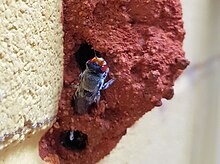Megachile aurifrons is a species of bee in the family Megachilidae.[2] It was described by Frederick Smith in 1853.[2]

| Megachile aurifrons | |
|---|---|

| |
| Scientific classification | |
| Domain: | Eukaryota |
| Kingdom: | Animalia |
| Phylum: | Arthropoda |
| Class: | Insecta |
| Order: | Hymenoptera |
| Family: | Megachilidae |
| Genus: | Megachile |
| Species: | M. aurifrons
|
| Binomial name | |
| Megachile aurifrons | |





An Australian native bee that is larger than the usual native bee, the Megachile aurifrons female bee measures about 12 mm in length, whilst the male is smaller at about 10 mm in length. It is the female bee that has the distinctive red eyes, whilst the male have eyes that are more milky coloured with red tint. Both male and female of the species have the “golden brow” on their faces, hence their common name of the ‘Golden-browed Resin Bee’. The ‘resin’ part of the name alludes to the resin they make to cap their nesting holes.[3]
The female of the species select and prepare the nesting cells for the next generation of bees. Once each cell is cleaned and lined/filled with pollen/nectar, the female Megachile aurifrons lays a single larva in the cell and then seals the cell with a resin cap.[4]

What the Megachile aurifrons select for creating her nesting cells can vary, from disused mud nests created by mud wasps, "bee hotels" found in urban gardens, and even old irrigation pipe pipes that may be found laying around.[5]
References edit
- ^ Smith, Frederick (1853). Catalogue of hymenopterous insects in the collection of the British Museum. Part I. Andrenidae and Apidae. London: British Museum (Natural History). pp. 1–197. Retrieved 21 October 2018.
- ^ a b "Megachile". BioLib. 2014. Retrieved 30 September 2014.
- ^ "Megachile aurifrons". ausemade.com.au. Retrieved 2021-11-27.
- ^ "Megachile aurifrons – capping the nest". ausemade.com.au. Retrieved 2023-05-07.
- ^ "Megachile aurifrons – opportunity knocks". ausemade.com.au. Retrieved 2023-05-07.